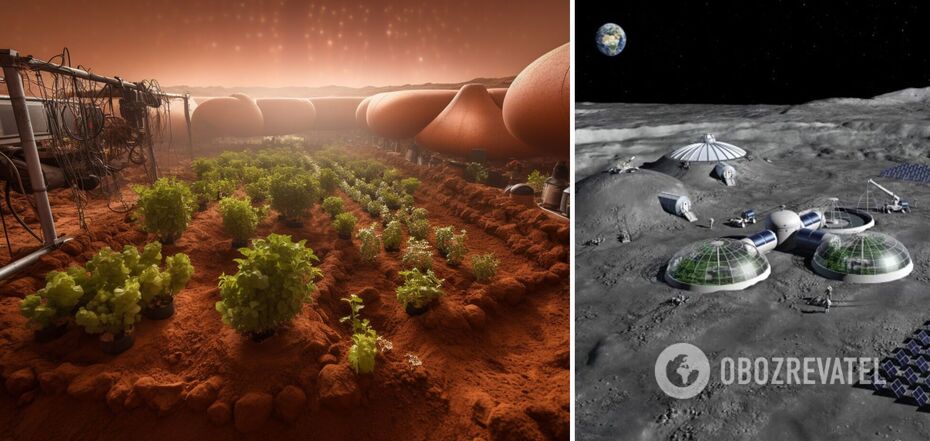Life
Will people be able to grow plants on the Moon: NASA already knows the answer
Although most of the talk is about the possible colonisation of Mars in the future, the Earth's satellite, the Moon, should also become a place of refuge for people. Of course, not like the red planet, where terraforming can theoretically be carried out, turning a dead planet into a living one. The Moon can become a kind of space hub for humanity, from which rockets will be launched into deep space.
And, of course, if people are going to live there, certain living conditions will have to be created. In particular, the conditions that will allow us to grow food on the Moon, because a constant supply of food from the Earth will make it equal in value to gold.
Fortunately, NASA has already calculated everything and knows whether it is possible to grow food for astronauts on the Moon. OBOZREVATEL has the details.
For the experiments, the scientists used samples of lunar surface material known as regolith, brought back 50 years ago by the astronauts of the Apollo missions. The six Apollo missions collected 2,200 samples of the material, totalling 381 kilograms, from which more than 110,000 individually catalogued specimens were created.
Samples from three of the missions were used by scientists for an experiment that (spoiler!) proved successful.
For the first time in history, researchers have grown the hardy and well-studied flower Arabidopsis thaliana in nutrient-poor lunar regolith.
This plant, common in Eurasia and Africa, is a relative of mustard and other cruciferous vegetables such as broccoli, cauliflower and Brussels sprouts.
Due to its small size and ease of growth, it is one of the most studied plants in the world. This is the reason why Thal's rhizobia is used as a model organism for research in all areas of plant biology. Scientists already know what its genes look like, how it behaves in different circumstances, and even how it grows in space.
To grow Arabidopsis, the team used samples collected during the Apollo 11, 12 and 17 missions, with only a gram of regolith per plant, to which water was added and then seeds. The plant trays were then placed in special boxes in a clean room and a nutrient solution was added daily.
"Two days later, they began to sprout. Everything sprouted. I can't tell you how surprised we were! Every plant - whether in the lunar sample or in the control sample - looked the same until about the sixth day," Anna-Lisa Paul, a professor of horticultural sciences at the University of Florida, told Communications Biology.
However, after the sixth day, it became clear to the scientists that the plants in the lunar soil were not as strong as the plants in the control group that grew in volcanic ash. The "lunar" plants grew more slowly and had stunted roots; in addition, some of them had stunted leaves and reddish pigmentation.
After 20 days, before the plants began to flower, the researchers harvested them and ground them up for RNA analysis.
The RNA sequencing revealed gene expression patterns that showed that the plants were stressed and reacted similarly to those growing in soil with too much salt or heavy metals.
In addition, it turned out that the plants grown on the Apollo 11 samples were not as strong as the other two sets. Nevertheless, the scientists note, they grew.
Next, the scientists intend to understand whether it will be possible to genetically adapt plants to grow on lunar soil, as well as how to reduce the stressful nature of lunar soil.
The scientists explain that this research is "crucial to NASA's long-term goals", as humanity will need to grow food for astronauts on both the Moon and Mars, despite how unsuitable they may seem now.
"First, we asked the question whether plants can grow in regolith. And secondly, how this could one day help people to extend their stay on the moon," said Robert Fearl, a study participant and professor of horticultural sciences at the University of Florida in Gainesville.
Despite the fact that the plants grown in regolith were not as robust as those grown in terrestrial soil, scientists still believe that a strong "yes" can be said to the question of growing plants on the Moon.
Now they are trying to understand how to use the results of the experiments to provide food for astronauts who could grow nutrient-rich plants on the Moon in the future.
"To explore further and learn about the solar system we live in, we need to take advantage of what's on the Moon, so we don't have to take it all with us," said Jacob Bleacher, principal investigator supporting NASA's Artemis programme.
According to him, NASA is sending robotic missions to the south pole of the Moon, where it is believed there may be water that astronauts can use later.
"Moreover, growing plants is something we will study when we go there. So, this research on Earth paves the way for the next humans to expand this research on the Moon," he said.
Earlier, OBOZREVATEL also told what scientists know about the possibility of growing potatoes on Mars.
Subscribe to OBOZREVATEL's Telegram and Viber channels to keep up with the latest news.































